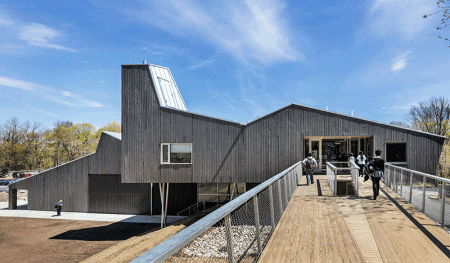
Murray Grove, a nine-story residential building in London designed by Waugh Thistleton Architects, was the world’s first multistory building to have load-bearing walls, floor slabs, stairs, and elevator cores constructed entirely out of mass timber. (Photo: Will Pryce/Courtesy: Waugh Thistleton Architects)
Taller buildings constructed mainly of wood are an inexpensive, attractive, and environmentally friendly option, but current building codes in the United States make them hard to build, said a panel of architects and engineers speaking in October at the National Building Museum in Washington, D.C.
“Mass timber buildings”—where most, if not all, of the structural elements of a building are made of wood—have slowly been gaining acceptance. Despite wood’s reputation as “little sticks,” as Hans-Erik Blomgren of Arup initially described it, wood can in fact support buildings as high as 15, 18, even 30 stories—leading some observers to dub these new structures “plyscrapers.”
But almost all of the mass timber buildings built or under construction are outside the United States, because building codes have not yet caught up with the research.
“My boss at my first job out of school called it termite food,” Blomgren said. “It decays, it burns, it shrinks, warps, and twists. All these issues are out there that on first blush you question the ability of the material to work for you.” And yet, “every year or two, a new building’s being built” of wood.
Related: Reduced Parking, Wood Construction Could Help Keep Construction Costs Down
Blomgren, along with Christopher Sharples of SHoP and Thomas Robinson of LEVER Architecture, came to the Building Museum in conjunction with the museum’s Timber City exhibit, which shows off how this very old material is transforming cities.
Why Wood?
Wood has been a building material almost since primitive man rubbed two sticks together. And impressive wood structures built hundreds of years ago are still standing (think Horyu-ji temple in Japan, built in the eighth century, or the impressive stave churches in Scandinavia). But when steel and concrete became the building medium of choice, wood fell by the wayside.
That is a shame, said all three panelists. (It should be noted, however, that all three have skin in the game: SHoP and LEVER shared the $3 million winnings from the first U.S. Tall Wood Building Competition and Arup consulted on both projects.) Wood, when formed into engineered products like cross-laminated timber, is strong. (When LEVER tested a CLT panel, it failed only at 520,000 pounds of pressure.) It’s also, by some metrics, an environmentally friendly material. That sounds counterintuitive, but the truth is that wood from well-managed forests is a carbon sink. In some cases, CLT can even be made from wood that would otherwise be thrown away, such as trees killed by the mountain pine beetle.
Wood in Cities
In New York, where SHoP is proposing the competition-winning 475 West 18th (“the tallest building in the city to use structural timber, pending approvals from the New York City Department of Buildings”), wood offers more benefits. Because the building can be prefabricated off site and assembled much more quickly than a traditional concrete-and-steel one, “the quality of life is much nicer near a wood site,” Sharples said.
Robinson agrees. In addition to designing Framework, the West Coast winner of the Tall Wood Building Competition, Lever recently moved its offices into Albina Yard, a mass timber building it also designed. “The crew that built our office just loved it, it’s easier,” he said. “The entire 4,000-square-foot [372 sq m] floor came on one truck. It took them two and a half hours to place the panels, and they spent the next day screwing them in. If that was done with traditional [methods], it would take them a week.”
The architects also pointed to the aesthetic qualities of wood; in some mass timber buildings, the wooden elements are covered by Sheetrock, but in others it is left exposed. “You go to old wood churches and it’s a moving experience,” said Robinson. “You have a better shot of getting to that experience with this material.”
What’s the Catch?
In general (codes are complicated things), the International Building Code doesn’t explicitly allow CLT as a building medium for structures over six stories. “We live in a very prescriptive world when it comes to code,” Sharples said. The code does say, however, that building materials not specifically mentioned can be used if a builder can demonstrate that they are “equivalent” in important ways like safety. This basically makes approval of mass timber buildings in the United States a case-by-case basis. LEVER Architecture recently demonstrated that the materials it’s using for Framework can withstand a two-hour burn test; SHoP is currently “in the process of working with the fire department to prove out the performance of this system.” But proving that out to modern standards is still required.
Changes are eventually coming to the code: “Good things are happening,” Blomgren said.
Finally, despite impressive renderings of 80-story wooden skyscrapers, the practical upper limit—for now—for a mass timber building seems to be about 14 stories. Because wood is so much lighter than steel and concrete, buildings that tall start to sway in the wind more than human occupants really like. “The good news is there are technologies for adding damping to a building,” Blomberg said. “It’s not a barrier” forever.
Longevity
Architects want their buildings to last forever. The truth is, however, that styles and needs change and buildings fall out of favor. It remains to be seen whether the new mass timber buildings will have staying power like the 100-year-old buildings still standing in New York, or if they will be torn down in a few decades. The good news is that the materials inside a mass timber building have value and can fairly easily be salvaged. “We could unscrew our entire building,” said Robinson.
This discussion was part of the Timber City exhibit showing at the National Building Museum in Washington, D.C., until May 21.







